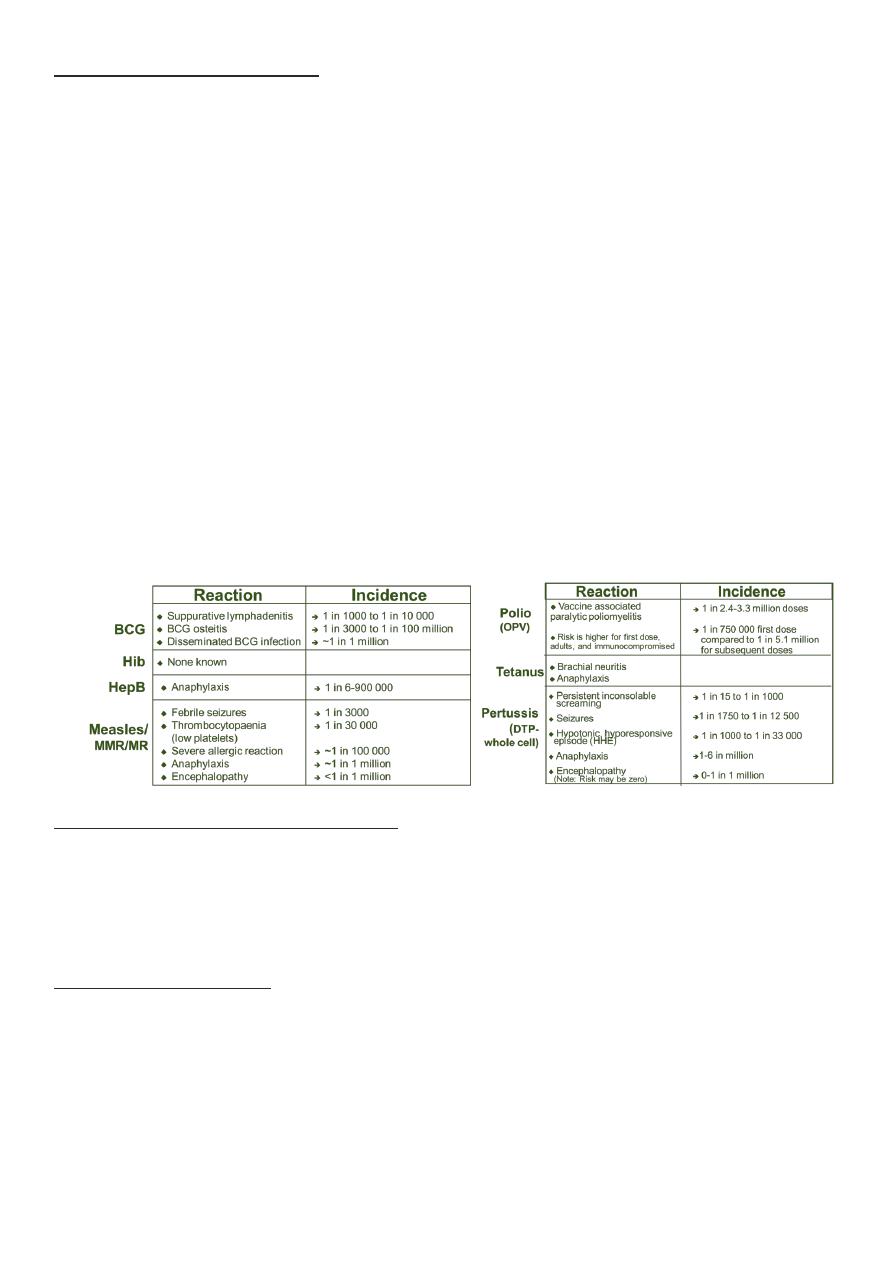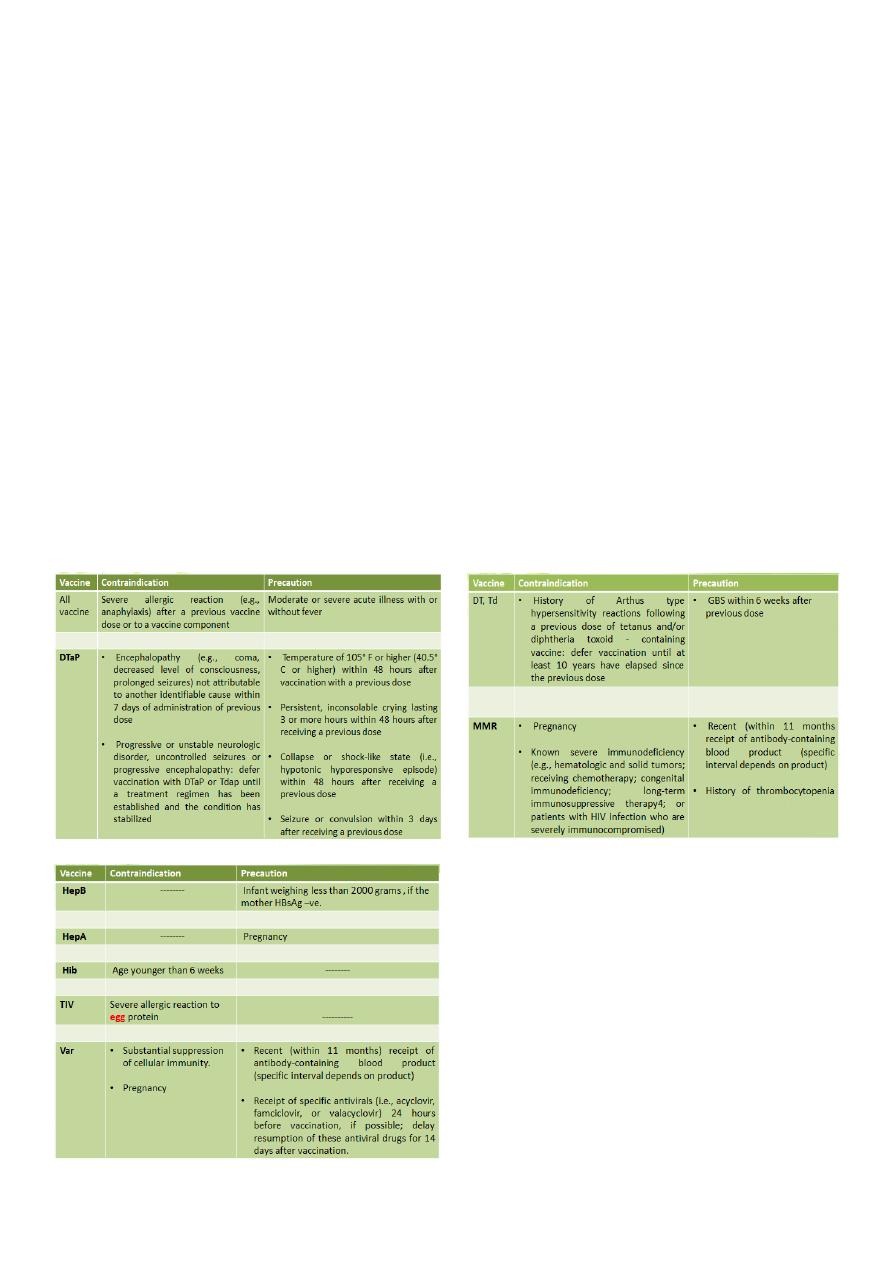
1
Pediatrics
Vaccination
----------------------------------------------------------------------------------------------
www.facebook.com/ibnlatef
https://goo.gl/RpvNsl
Ibnlatef
Notes

2
Subject1:
Introduction
Immunity:
The immune system is a complex network of specialized organs and cells protects the
body from destruction by foreign agents and microbial pathogens, degrades and removes
damaged or dead cells, and exerts a surveillance function to prevent the development and
growth of malignant cells.
The immune system is composed of immune cells and central and peripheral lymphoid
structures.
The immune cells move throughout the body, searching for and destroying foreign
substances but avoiding cells regarded as self.
Natural immunity it is not produced by the immune response. This type of immunity is
present at birth and appears to be present in all members of a species.
Acquired immunity it develops after birth as a result of exposure to an antigen, thereby
activating the immune response. Acquired immunity can be either active or passive,
depending on whether the immune response took place in the host or a donor.
Differences of immune system of children and adult:
The normal human no fully active immune system at birth because of immaturity.
It relies instead on passively transferred antibodies from the mother.
This maternal antibody slowly decreases in concentration and for all practical purposes,
has waned by 1 year.
The infant own production of antibody begins to be meaningful at 7 or 8 months of age
when the total of maternal and infant antibody is low.
One has waned and the other is not up to full strength.
This is age when many of the infectious disease processes of infancy begin /e.g. otitis
media, pneumonia.
Active Immunization:
Process of inducing prolonged humeral and/or cellular immune response by administering
a vaccine or toxoid.
Passive immunity:
Passive immunity is achieved by administration of preformed antibodies to induce
transient protection against an infectious agent.

3
Passive immunity also can be induced naturally through transplacental transfer of
maternal antibodies (IgG) during gestation.
Maternally derived transplacental antibodies can provide protection during an infant's
first months of life.
Sources of passive immunity:
Almost all blood or blood products.
Homologous pooled human antibody (immune globulin).
Homologous human hyperimmune globulin.
Heterologous hyperimmune serum (antitoxin).
The major indications for passive immunity are to provide protection to:
Immunodeficient children with B-lymphocyte defects who have difficulties making
antibodies.
Persons exposed to infectious diseases or who are at imminent risk of exposure where
there is no adequate time for them to develop an active immune response to a vaccine.
Persons with an infectious disease as part of specific therapy for that disease.
Vaccine preventable diseases:
An infectious disease for which an effective preventive vaccine exists.
If a person dies from it, the death is considered a vaccine-preventable death.
Terms:
Fully immunized child:
o
A child who received:
One dose of BCG.
Three doses of DPT and OPV.
One dose of measles.
Before one year of age.
o
This gives a child the best chance for survival.
Control:
o
Reduction of prevalence or incidence of disease to lower acceptable level.
Elimination:
o
Eradication of disease from a large geographic region or political jurisdiction.
o
Either reduction of infectious disease’s prevalence in regional population to zero or
reduction of global prevalence to a negligible amount.

4
Eradication:
o
Termination of all transmissions of infection by extermination of infectious agent
through surveillance and containment.
o
Reduction of infectious disease’s prevalence in global host population to zero.
Expanded programme on immunization (EPI):
EPI launched in 1974.
Build on smallpox infrastructure.
Targeted 6 diseases.
EPI progressively adopted by all countries universal by early 1098s.
Addition to EPI Yellow fever in 1988, Hepatitis B in 1992, Haemophilus influenzae type
b (Hib).
Component of program:
o
Immunization of pregnant women against tetanus.
o
Immunization of children in their first year of life against 6 VPDs.

5
Subject2:
Immunoglobulin
Immunoglobulin IG:
IG is a sterile antibody-containing solution, usually derived from adult human plasma.
Normal human Ig:
Normal human Ig is an antibody-rich fraction, obtained from a pool of at least 1000
donors.
The preparation should:
o
Contain at least 90% intact IgG.
o
It should be as free as possible from IgG aggregates.
o
All IgG sub-classes should be present.
o
There should be a low IgA concentration.
o
The level of antibody against at least two bacterial species and two viruses should be
ascertained.
Normal human Ig used to prevent measles in highly susceptible individuals and to provide
temporary protection “up to 12 weeks” against hepatitis A infection.
Live vaccines should not normally be given for 12 weeks after an injection of normal
human Ig.
Specific human Ig:
These preparations are made from the plasma of patient who have recently recovered
from an infection.
Or are obtained from individuals who have been immunized against a specific infection.
Hepatitis B immune globulin (IM).
Rabies immune globulin (IM).
Tetanus immune globulin (IM).
Varicella-zoster immune globulin (VZIG) (IM) or IVIG.
Hyperimmune animal antisera preparations:
Animal antisera preparations are derived from horses.
2 horse antisera preparations are available for humans: diphtheria antitoxin, which is used
to treat diphtheria, and botulinum antitoxin.
Great care must be exercised before administering animal-derived antisera because of the
potential for severe allergic reactions.

6
Monoclonal antibodies:
Monoclonal antibodies are antibody preparations produced against a single antigen.
A major monoclonal antibody used in infectious diseases is palivizumab, which can
prevent severe disease from respiratory syncytial virus (RSV) among children ≤24 mo of
age with chronic lung disease, with a history of premature birth, with congenital heart
lesions or with neuromuscular diseases.
The advantages of Ig-s are:
Freedom from hepatitis B.
Concentration of the antibodies into a small volume for intramuscular use.
Stable antibody content, if properly stored.
Indication of IG:
IG for I.M injection:
o
Replacement therapy in antibody deficiency disorders.
o
Hepatitis A prophylaxis.
o
Measles prophylaxis.
IG for I.V injection:
o
Replacement therapy in antibody deficiency disorders.
o
Kawasaki disease.
o
Pediatric HIV.
o
Hypogammaglobulinemia in chronic B-cell lymphocytic leukemia.
o
Bone marrow transplantation.
o
May be useful in a variety of other conditions as Guillain-Barre syndrome, immune
mediated thrombocytopenia, severe toxic shock syndrome.
Adverse reaction to IG:
IGIM:
o
Pain and discomfort at the injection site.
o
Less common flushing, headache, chills, nausea.
o
Rare & serious chest pain, dyspnea, anaphylaxis, systemic collapse.
IGIV:
o
Fever, headache, myalgia, chills, nausea, vomiting.
o
Rare & serious anaphylactoid events, thromboembolic disorders, aseptic
meningitis, renal insufficiency.

7
Subject3:
Vaccination
Vaccination:
Administration of a substance to a person with the purpose of preventing a disease
Traditionally composed of a killed or weakened microorganism
Vaccination works by creating a type of immune response that enables the memory cells
to later respond to a similar organism before it can cause disease
Vaccines have been made for only 34 of the more than 400 known pathogens that are
harmful to man.
Immunization saves the lives of 3 million children each year, but that 2 million more lives
could be saved if existing vaccines were applied on a full-scale worldwide.
Human Vaccines against pathogens:
Type of Vaccination:
Live Vaccines:
o
Characteristics:
Able to replicate in the host.
Attenuated (weakened) so they do not cause disease.
o
Advantages:
Induce a broad immune response (cellular and humoral).
Low doses of vaccine are normally sufficient.
Long-lasting protection are often induced.
Summary of vaccines types:
Bacterial vaccine:
o
Live attenuated: BCG.
o
Killed vaccine: pertussis.
o
Toxoid: tetanus.
o
Polysaccharide: pneumococcus.
Viral vaccine:
o
Live attenuated: measles, mumps, rubella
[MMR], varicella, nasal influenza.
o
Completely inactivated: polio, hepatitis A,
intramuscular influenza.
o
Recombinant
products: hepatitis B, human
papillomavirus.
o
Reassortants: rotavirus.

8
o
Disadvantages:
May cause adverse reactions.
May be transmitted from person to person.
Subunit Vaccines:
o
Relatively easy to produce (not live).
o
Classically produced by inactivating a whole virus or bacterium by Heat, Chemicals.
o
The vaccine may be purified selecting one or a few proteins which confer
protection.
o
Bordetella pertussis (whooping cough) create a better-tolerated vaccine that is free
from whole microorganism cells
Subunit Vaccines (Polysaccharides):
o
Many bacteria have polysaccharides in their outer membrane.
o
Polysaccharide based vaccines:
Neisseria meningitides.
Streptococcus pneumoniae.
o
Generate a T cell-independent response:
Inefficient in children younger than 2 years old.
Overcome by conjugating the polysaccharides to peptides.
Subunit Vaccines (Toxoids):
o
Toxoid: modified bacterial toxin that is made nontoxic but is still able to induce an
active immune response against the toxin.
o
It is produced by an individual’s own immune system and is usually long-lasting, e.g.
tetanus & diphtheria
o
Responsible for the pathogenesis of many bacteria.
o
Inactivated toxins.
o
Toxoid based vaccines:
Bordetella pertussis.
Clostridium tetani.
Corynebacterium diphtheria.
o
Inactivation:
Traditionally done by chemical means.
Altering the DNA sequences important to toxicity.
Subunit Vaccines (Recombinant):
o
The hepatitis B virus (HBV) vaccine:
Originally based on the surface antigen purified from the blood of chronically
infected individuals.
Due to safety concerns, the HBV vaccine became the first to be produced using
recombinant DNA technology (1986).
Produced in bakers’ yeast (Saccharomyces cerevisiae).
o
Virus-like particles (VLPs) :
Viral proteins that self-assemble to particles with the same size as the native virus.
VLP is the basis of a promising new vaccine against human papilloma virus (HPV)
Merck, in phase III.

9
Genetic Vaccines:
o
Introduce DNA or RNA into the host:
Injected (Naked).
Coated on gold particles.
Carried by viruses vaccinia, adenovirus, or alphaviruses.
Carried by bacteria Salmonella typhi, Mycobacterium tuberculosis.
o
Advantages:
Easy to produce.
Induce cellular response.
o
Disadvantages:
Low response in 1st generation.
Vaccine cold chain:
Maintaining proper vaccine temperatures during storage and handling to preserve
potency.
The success of efforts against vaccine-preventable diseases is attributable in part to
proper storage and handling of vaccines.
Exposure of vaccines to temperatures outside the recommended ranges can affect
potency adversely, thereby reducing protection from vaccine-preventable diseases.

10
Subject4:
Vaccination in clinical practice
Iraqi schedule 2015
Iraqi schedule 2012
Age
BCG, OPV-0, HBV-1
BCG, OPV-0, HBV-1
At birth
HEXA1, ROTA1,PREV13-1+OPV1
PENTA valent vaccine (DTP-1, Hib1,
and HBV-2), OPV1 and Rotavirus1
2 months
HEXA2,ROTA2, PREV13-2 +OPV2
TETRA1 vaccine (DTP-2, and Hib2)
OPV2 and Rotavirus2
4 months
HEXA3,ROTA3, PREV13-3 +OPV3
Pentavalent vaccine (DTP-3, Hib3, and
HBV-3), OPV3 and Rotavirus3
6 months
Measles + VIT A
Measles + VIT A
9 months
MMR1
MMR1
15 months
DTP+ IPV+ Hib + OPV + VIT A
TETRA2 vaccine (DTP, and Hib) OPV.
(booster no.1)
18 months
DTaP + IVP + OPV + MMR2
DTP, OPV (booster no.2) and MMR2
4-6 years
Name
In Arabic
Type
Route
BCG
بي سي جي
Live attenuated TB bacteria
ID
HBV
إالتهاب الكبد
الفيروسي ب
Inactivated hepatitis B virus
IM
OPV
شلل األطفال فموي
Live attenuated Polio virus
Oral
RV
الفا
يروس العجلي
Live attenuated Rotavirus
Oral
Measles
الحصبة المنفردة
Live attenuated measles virus
SC
MMR
الحصبة المختلطة
Live attenuated, mumps, rubella viruses
SC
DTP
اللقاح الثالث
ي
Diphtheria and Tetanus Toxoid + inactivated
pertussis bacteria
IM
DTP-Hib
اللقاح الرباعي
DTP + Inactivated Influenza virus
IM
DTP-HepB-Hib
اللقاح الخماسي
DTP + Inactivated Influenza virus +
Inactivated hepatitis B virus
IM
DTP-HepB-Hib-
IPV
اللقاح ا
لسداسي
DTP + Inactivated Influenza virus +
Inactivated hepatitis B virus + injectable
Polio Vaccine
IM
PREV13
نيوموكوكل
Pneumococcal Conjugate Vaccine
SC

11
Types of vaccines:
Live attenuated Vaccine
Inactivated organism or their products
o
BCG
o
OPV
o
Measles
o
Rubella
o
Mumps
o
Varicella Vaccine
o
Rotavirus
o
Live-attenuated influenza vaccine
o
Diphtheria
o
Tetanus
o
Pertussis (whole cell/acellular)
o
Hepatitis A
o
Hepatitis B
o
Pneumococcal Polysaccharide vaccine
o
Inactivated influenza
o
IPV
o
Hib
o
HPV
o
meningococcal
Vaccination check list:
Be sure to ask these questions before giving the vaccines:
Is your child sick today? (More than a common cold, earache, etc.)
Does your child have any severe (life-threatening) allergies?
Has your child ever had a severe reaction after a vaccination?
Does your child have a weakened immune system (because of diseases such as cancer, or
medications such as steroids)?
Has your child gotten a transfusion, or any other blood product, recently?
Has your child ever had convulsions or any kind of nervous system problem?
Does your child not seem to be developing normally?
Children who are allergic to eggs can have all the usual childhood immunizations. The only
immunization that should be avoided if your child is allergic to egg is influenza vaccine.
Even if your baby is premature,the infant immunizations start at the baby's chronological
age, not their gestational age.
Constraints of vaccination:
Illiteracy.
Non uniform coverage.
Poor implementation, Poor monitoring.
High drop outs.
Declining coverage in some major states.
Over reporting.
Poor injection safety.
Reorientation of staff being not carried out.
Vacany of staff at field level not filled.
Poor surveillance of vaccine preventable diseases.
Poor vaccine logistics.
Poor maintenance of equipments.
Extra ordinary emphasis on polio vaccine.

12
Contraindications to vaccination:
1-Allergy:
Allergic Reactions to Egg-related antigens:
o
Yellow fever and influenza vaccines do contain egg proteins and rarely induce
immediate allergic reactions.
o
Skin testing is recommended before administration with an history of allergic to egg.
o
MMR Even those with severe hypersensitivity are at low risk of anaphylaxis.
Antibiotic-induced allergic reaction:
o
Delayed type local reaction 48-96 hours afterwards and is usually minor.
o
IPV and OPV streptomycin, neomycin and polymyxin B.
o
MMR and varicella vaccine neomycin.
Gelatin: MMR, varicella vaccine.
2-Fever:
Low-grade fever or mild illness is not a contraindication for vaccination.
Children with moderate or severe febrile illnesses can be vaccinated as soon as they are
recovering and no longer acutely ill.
3-HIV Infection:
No BCG.
OPV is contraindicated:
o
In household contact, in recipient (asymptomatic or symptomatic).
o
IPV for these children and household contacts.
MMR vaccination should be considered for all asymptomatic and to all symptomatic HIV-
infected persons who do not have evidence of severe immunosuppression or measles
immunity.
Pneumococcal vaccine, Hib, DTP (or DTaP), Hepatitis B vaccine, Influenza vaccines are all
indicated.
4-Immunosuppression:
No live viral vaccines and BCG. IPV for these patients, their siblings and their household
contacts.
No live vaccine (except varicella) until six months after immunosuppressive therapy.
5-Neurological disorder:
Progressive developmental delay or changing neurological findings (e.g. infantile spasm)
defer pertussis immunization.
Personal history of convulsions, recent seizures defer pertussis immunization.
Conditions predisposing to seizures or neurological deterioration (e.g. tuberous sclerosis)
defer pertussis immunization.

13
6-Reactions to previous vaccine:
Severe Reactions to DTP:
o
Insonable cry lasting more than 3 hrs with 48 hrs of dose.
o
Seizure with 3 days.
o
Severe local reactions.
o
Family hx of adverse event.
o
Not a contraindication, but consider carefully the benefits and risks, if need to
vaccinate can use acellular DTP for less reactions.
o
GBS with 6 weeks after a dose of DTP again based on risks and benefits for further
dose of DTP and risk of GBS recurrence.
o
Contraindication for further dose of DTP encephalopathy within 7 days of a dose of
DTP.
Common minor reactions:
o
Vaccine stimulates immune system.
o
Settle on their own.
o
Warn parents and advise how to manage.
Rare more serious reactions:
o
Anaphylaxis (serious allergic reaction).
o
Vaccine specific reactions.
7-Simutaneous administration of Vaccine:
A
theoretical risk that administration of multiple live virus vaccine (OPV, MMR, varicella)
within 28 days of one another if not given on the same day will result in a sub optimal
immune response.
No data to substantiate this.
8-Other contraindications:
IG administration.
Prematurity.
Thrombocytopenia.

14
The following individuals should not receive live vaccines:
Patients with evidence of severe primary immunodeficiency (SCI), or secondary (HIV).
Patients receiving systemic high-dose steroids, until at least 1 months after treatment has
stopped. This would include children who receive prednisolone, orally or rectally, at a
daily dose (or its equivalent) of 2mg/kg/day for 2week, or 1mg/kg/day for one month.
Patients who have received a solid organ transplant and are currently on
immunosuppressive treatment, at least 3-6 months after stopping treatment.
Patients currently being treated for malignant disease with immunosuppressive
chemotherapy or radiotherapy, or who have terminated such treatment within at least
the last 6 months, and disease in remission.
Patients who have received a bone marrow transplant, until at least 12 months after
finishing all immunosuppressive treatment, or longer where the patient has developed
graft-versus-host disease.
There is a theoretical concern that vaccinating pregnant women with live vaccines may
infect the fetus, there is no evidence that any live vaccine (including rubella and MMR)
causes birth defects, live vaccines should generally be delayed until after delivery,
t
ermination of pregnancy following inadvertent immunization is not recommended
Conditions are NOT contraindications to immunization:
Mild acute illness ± fever.
Mild-moderate local reaction.
Family history of any adverse reactions following immunization.
Prematurity.
Stable neurological conditions such as well controlled convulsion, cerebral palsy, Down’s
syndrome.
History of other non-vaccine allergic condition as hay fever, penicillin allergy, etc.
Close contact of an immunosuppressed individual, except for OPV.
Vaccination in pregnancy:
Risk to a developing fetus from vaccination of the mother during pregnancy is mostly
theoretical.
Only smallpox vaccine has ever been shown to injure a fetus.
The benefits of vaccinating usually outweigh potential risks.
Inactivated vaccines:
o
Routine (influenza).
o
Vaccinate if indicated (hep B, Td, mening, rabies).
o
Vaccinate if benefit outweighs risk (all other).
o
Live vaccine – do not administer.
o
Exception is yellow fever vaccine.

15
General Principles of Childhood Vaccination
Live-attenuated vaccines (MMR, varicella, LAIV) if not administered on the same day,
should be given at least 1 month apart.
IG does not interfere with killed vaccines. However, IG can interfere with the immune
response to measles and varicella vaccine. Depending on the dose of IG received, MMR &
var vaccine should be deferred for as long as 3-11 months.
IG is not expected to interfere with the immune response to LAIV or rotavirus vaccines.
Premature infants should be kept on the same schedule as full-term infants.
Children whose vaccination status is uncertain should be considered unimmunized and
should be given appropriate vaccines.
Immunization in preterm infants:
o
All vaccines except Hepatitis B.
o
If BW < 2Kg & mother HBsAg negative postpone till baby attained 2kg wt or 2
months of age.
o
If BW < 2Kg & mother HBsAg positive give vaccine + immunoglobulin.
Contraindication & Precaution to Vaccine:

16
Subject5:
Important vaccines
Bacille Calmette-Guẻrin (BCG) vaccine:
The live attenuated strain of Mycobacterium bovis known as bacillus Calmette-Guérin
(BCG) uses shared antigens to stimulate the development of cross-immunity to
Mycobacterium tuberculosis.
Benefit:
o
No prevention of tuberculosis.
o
BCG Prevents life-threatening complications such as meningitis and miliary TB.
Administration:
o
Give 0.1
ml (0.05ml until one month of age).
o
BCG is given as a single intradermal injection at the insertion of the deltoid into the
lateral aspect of the left upper arm.
o
Local complication rate is smallest when that site is used.
Successful BCG vaccination:
o
Small bleb is raised and a successful vaccination leads to the development of a small
local swelling within 2 weeks.
o
The lesion progresses to a papule or shallow ulcer of approximately 10 mm
diameter and heals within 12 weeks to form a small, flat scar.
Adverse effects:
o
Local ulceration and regional suppurative adenitis occur in 0.1-1% of recipients.
o
Keloids: large, raised and ugly scars.
o
If BCG is accidentally given to an immunocompromised patient, it can cause
disseminated or life threatening infection.
Notes:
o
BCG vaccination administered during infancy has little effect on the ultimate
incidence of tuberculosis in adults, suggesting that the effect of the vaccine is time
limited.
o
It gives protection against T.B for at least 15 yr.
o
After receiving the vaccine, the child should be separated from the possible sources
of infection until it can be demonstrated that the child has had a vaccine response,
demonstrated by tuberculin reactivity, which usually develops within 1–3 mo.
o
Occasionally, a 2nd BCG vaccination must be given to children who fail to develop
skin test reactivity after the 1st dose.
Polio vaccine:
Virus:
o
Enterovirus (RNA), Three serotypes: 1, 2, 3
o
Human is the reservoir, transmission by fecal-oral.

17
o
The virus present in stool for 3-6 weeks.
Salk’s Polio vaccine “Inactivated Polio Vaccine” IPV, injectable:
o
Based on polio grown in a type of monkey kidney tissue culture, which is then
inactivated with formalin.
o
Contains 3 serotypes of vaccine virus.
o
The injected Salk vaccine confers IgG-mediated immunity in the bloodstream, which
prevents polio infection from progress to viremia and protects the motor neurons,
thus eliminating the risk of bulbar polio and post-polio syndrome.
o
It offers no protection to the mucosal lining of the intestine, ie; people vaccinated
with Salk's vaccine can still carry the disease and spread it to unvaccinated
individuals.
o
IPV has essentially no adverse effects associated with it other than possible rare
hypersensitivity reactions to trace quantities of antibiotics.
Sabin's polio vaccine “Oral live-attenuated vaccine”:
o
Sabin's “Oral Polio Vaccine" is a live-attenuated vaccine.
o
Contains 3 serotypes of vaccine virus.
o
It replicates very efficiently in the gut, the primary site of infection and replication
(confers local GI immunity).
o
Unable to replicate efficiently within nervous system tissue.
o
Shed in stool for up to 6 weeks following vaccination.
Advantages & Disadvantages of Oral Polio Vaccines:
o
The OPV proved to be superior in administration, and also provided longer lasting
immunity than the Salk vaccine.
o
The trivalent Oral Polio Vaccine (Sabin) on very rare occasions has been associated
with paralysis (vaccine- associated paralytic poliomyelitis, about 1 case per 750,000
vaccine recipients).
IPV elicits higher serum IgG antibody titers, but the OPV also induces significantly
greater mucosal IgA immunity in the oropharynx and gastrointestinal tract that limits
replication of the wild poliovirus at these sites.
DPT (Diphtheria, Pertussis, Tetanus) vaccine:
Administration:
o
DTP and DTaP (acellular) are administered in a dose of 0.5 mL intramuscularly in
antero-lateral side of mid-thigh, at 2, 4, 6 months.
o
One booster at 15-18 m with OPV booster (antero-lateral side of mid-thigh) and
second booster at 4-6 years (upper arm)
o
Local reactions include: inflammation, induration or a painless nodule at the site of
injection.
o
Local reactions are progressively more common after the first injection.
DTaP:
o
Minimum age 6 wk.

18
o
4th dose may be administered as early as age 12 mo, provided 6 mo have elapsed
since the 3rd dose.
o
Administer the final dose in the series at age 4-6yr.
dT:
o
The adult preparation (dT; 10% of pediatric diphtheria toxoid dose).
o
For individuals 7 years of age or older, dT is recommended for the primary series
and booster doses because the lower concentration of diphtheria toxoid is
adequately immunogenic and because increasing the content of diphtheria toxoid
heightens reactogenicity with increasing age.
Tetanus toxoid:
o
Intramuscular – upper arm – 0.5 ml.
o
Pregnancy – 2 doses - 1st dose as early as possible and second dose after 4 weeks
of first dose and before 36 weeks of pregnancy.
o
Pregnancy – booster dose (before 36 weeks of pregnancy) – If received 2 TT doses
in a pregnancy within last three years. Give TT to woman in labour, if she has not
received TT previously.
o
TT booster for both boys and girls at 10 years and 16 years.
o
No TT required between two doses in case of injury.
Absolute contraindications to DTP and DTaP:
o
Immediate anaphylactic reaction.
o
Encephalopathy within 7 days.
o
The latter is defined as a severe, acute central nervous system disorder unexplained
by another cause, which may be manifested by major alterations of consciousness
or by generalized or focal seizures that persist for more than a few hours without
recovery within 24 hours.
Precautions for immunization:
o
Are adverse events that were formally contraindications but now require careful
consideration before administration of additional doses.
o
These reactions have not proven to cause permanent sequelae.
o
They are:
Seizures with or without fever, occurring within 3 days of immunization with DTP
or DTaP.
Persistent, severe, inconsolable screaming or crying within 3 days for 3 or more
hours within 48 hours.
Collapse or shock-like state (hypotonic-hyporesponsive episode) within 48 hr.
Temperature ≥ 40.5°C (104°F), unexplained by another cause, within 48 hours.
MMR (Measles, Mumps, Rubella) vaccine:
Information:
o
Composed of three live attenuated vaccines (Measles, Mumps & Rubella).
o
This highly effective vaccine is administered subcutaneously in two doses.

19
o
The first MMR dose is recommended at age 12 to 15 months and the second at the
child's entry into school (age 4 to 6 years), A dose given before 12 months of age
will not be counted.
o
The purpose of the rubella portion of this vaccine is to protect against congenital
rubella syndrome by preventing the occurrence of rubella which, by itself, is a mild
disease.
o
For children who have not received 2 doses by 11-12 yr of age, a second dose
should be provided.
o
Infants who receive a dose before 12 mo of age should be given 2 additional doses
at 12-15 mo and 4-6 yr of age.
o
Measles vaccine for children 6-11 mo of age in epidemic situations or prior to
international travel.
Adverse effects:
o
Because MMR is a live-attenuated vaccine, non–allergy-related side effects are
noted 5 to 12 days following immunization.
o
Fever and rash are relatively common, experienced by 5% to 15% of recipients.
o
Transient arthritis has been reported.
o
Thrombocytopenia (rare).
o
Subacute sclerosing panencephalitis (SSPE).
o
Children prone to febrile seizures may experience an event following vaccination,
so the risks and benefits of vaccination should be discussed with parents.
Contraindications and precautions:
o
Severe allergic reaction to vaccine component or following prior dose.
o
Pregnancy.
o
Immunosuppression.
o
Moderate or severe acute illness.
o
Recent blood product.
Hepatitis B vaccine:
Administration:
o
HBV should be given to adolescents and children only in the deltoid muscle, and to
infants and neonates in the anterolateral thigh muscle as IM injection of 0.1 ml.
o
Administration intradermally or in the buttocks has resulted in poor immune
responses in some individuals, and these sites are not recommended.
At birth :
o
Administer monovalent HepB to all newborns before hospital discharge.
o
If mother is hepatitis surface antigen(HBsAg) +ve, adminster HepB and 0.5 ml of
(HBIG) simultaneously at different sites within 12 hr of birth.
o
If mother HBsAg status is unknown, administer HepB vaccine within 12 hr of birth.

20
o
Determine the HBsAg status as soon as possible & if HBsAg +ve, administer HBIG no
later than 1 week.
o
If mother is HBsAg –ve, the birth dose can only be delayed with physician’s order.
E.g. HepB vaccination should be deferred in infants weighing <2 kg at birth until 30
days of age.
After the birth dose:
o
The HepB series should be completed with either monovalent HepB or combination
vaccine containing HepB.
o
The final dose should not be administered before 6mo.
o
Infant born to HBsAg +ve mother should be tested for HBsAg & Ab to HBsAg after
completion of HepB series, at age 9-18 mo.
Rotavirus vaccine:
In early childhood, the single most important cause of severe dehydrating diarrhea is
rotavirus infection.
Rotaviruses; Reoviridae family.
The Pentavalent vaccine protects against rotavirus gastroenteritis.
Oral route.
Three doses; 2, 4, and 6 months.
Minimum age 6 wk.
Haemophilus influenzae type b (Hib) vaccine:
Type of vaccine: Conjugate.
Adverse reactions: Mild local reaction.
Injection site: Given IM in the outer mid-thigh for infants.
Minimum age 6wk.
Vaccine is not generally recommended for children ≥ 5 year.
If 1st dose was administered at age 7-11 months, administer 2 doses separated by 4
weeks + booster at age 12-15 mo.
In addition to these vaccines, others are recommended by AAP include:
Pneumococcal vaccine.
Influenza vaccine.
Varicella vaccine.
Hepatitis A vaccine.
Meningococcal polysaccharide vaccine.
Ibnlatef
Notes
Pediatric – Vaccination
